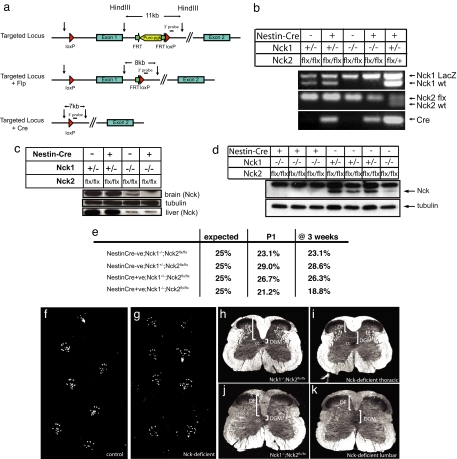Fig. 1.
Generation and characterization of mice containing a conditional allele of Nck2. (a) Schematic diagram of the strategy used to generate the conditional mutant of Nck2. (b) PCR genotyping of mice generated by crossing a Nck1−/−;Nck2flx/flx female with a Nck1+/−;Nck2flx/flx;Nestin-Cre male. An Nck1+/−;Nck2flx/wt;Nestin-Cre animal was included as a control (last lane). Top gel, Nck1 allele; middle gel, Nck2 allele; bottom gel, Cre. (c) Proteins isolated from the brain (top gel) or liver (bottom gel) of individual P1 mice, as noted, were immunoblotted with a pan-Nck antibody. (d) Dissociated cortical neurons from embryonic day-16 animals of various genotypes, as noted, were immunoblotted with a pan-Nck antibody (lower band, upper gel) and reprobed with tubulin (lower gel). Note the loss of Nck expression with decreasing Nck alleles [lanes 1–3 (0 alleles) < lane 7 (2 alleles) < lanes 4–6 (3 alleles)]. (e) Mendelian ratio of the offspring generated from crossing Nck1−/−;Nck2flx/flx females with Nck1+/−;Nck2flx/flx;Nestin-Cre males (n > 100 animals at each time point). (f and g) Hindpaw prints from a 12-week-old control mouse (Nck1−/−;Nck2flx/flx) (f) or a Nck-deficient mouse (Nck1−/−;Nck2flx/flx;Nestin-Cre) (g). (h–k) Dark-field photographs of spinal cord cross-sections at the thoracic (h and i) and lumbar (j and k) level of a control (Nck1−/−;Nck2flxflx) (h and j) and Nck-deficient (i and k) mouse. cc, central canal; DGM, dorsal gray matter.

